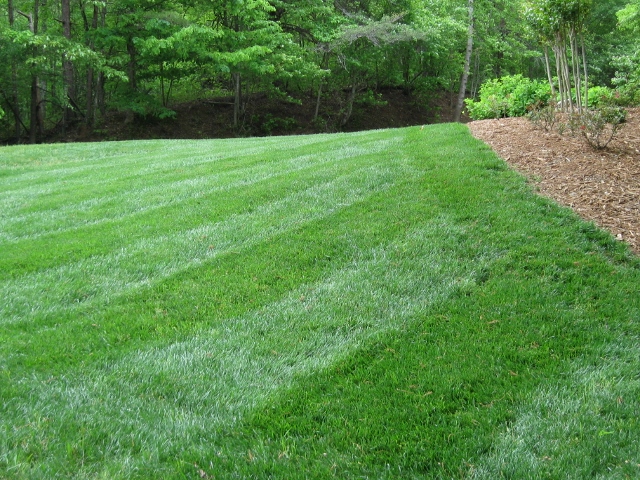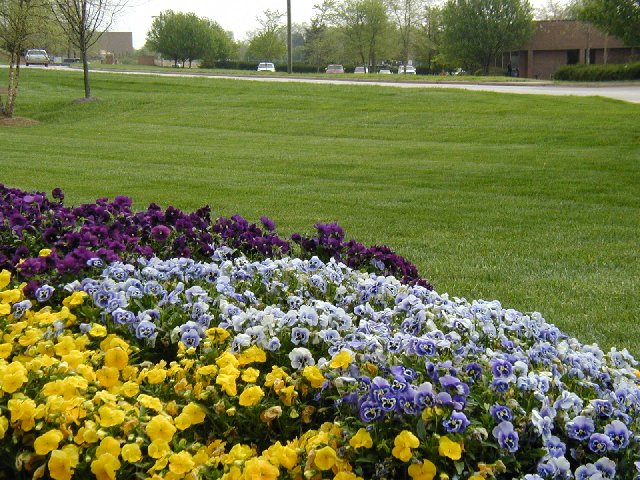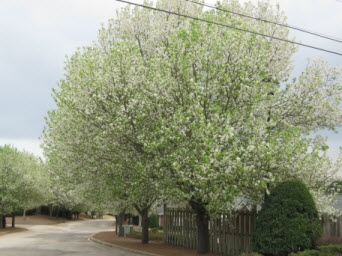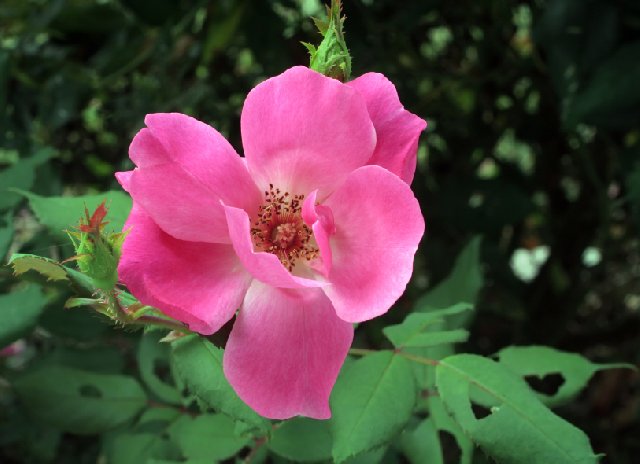|
|
Ornamental Trees & ShrubsWinter Landscaping & Lawn Care in the South
Along with fall and winter seasons come leaf fall. LMC becomes extremely busy during late fall and early winter with blowing and collecting leaves for our clients. Leaves are collected from lawns, planting beds, and paved areas every visit during the leaf season and placed at the curbside for pick up by the City of Gainesville Solid Waste Division or we dispose of the leaves on the client’s composting/dump area. Any leaves which must be removed from site will be transported to LMC’s composting facility. Mulching: After leaf fall and the collection and disposal of leaves, LMC becomes extremely busy with applying mulch to planting beds and natural areas during the winter months. Pine straw mulch or various types of bark mulches are applied as needed. Mulch is not only utilized for aesthetics, it also benefits plant growth by retaining soil moisture, moderating changes in soil temperature, and weed suppression. Pruning: Once ‘leaf season’ is over there are many pruning tasks that must take place while or before the mulching is going on. Some of these pruning tasks that take place in mid to late winter are: Pruning trees such as raising tree canopies for mower clearance and safety; pruning crape myrtles as necessary – (LMC’s policy - we do not severe prune crape myrtles unless necessary or if they need to fit a specific space.); cutting back groundcovers such as liriope and cleaning up daylilies and spent perennials; severe pruning (‘cutting back hard’) those receptive plants to re-establish plant boundaries; pruning ornamental grasses that are so numerous in the southern landscape; and pruning landscape plants such as certain hydrangeas, roses and butterfly bushes. Seasonal Color Care: We are fortunate to have a climate that allows the installation of certain annuals that remain hardy through our winter months and then provide a beautiful spring flush of color. Installation of winter hardy annuals such as pansies, violas, snapdragons and ornamental cabbages and kales takes place in October. Inspections and care of color plantings such as applying fertilizers to encourage flower production, weed control, identification of diseases and insects, and removal of spent blooms continues throughout the winter months. Landscaping (Tree Installation) In general, LMC encourages landscaping, especially most deciduous tree installations to be done during the late fall/winter months in our area when the rate of water loss from planted trees and shrubs is much less than if installed in the spring and summer months. A fall/winter installation in our area gives the plants time to become established before the summer’s heat, humidity and water stresses set in. Landscape Management Company provides landscaping and lawn maintenance services to clients throughout North Georgia. Contact us today for more information on winter landscaping and lawn care. Posted: December 5th, 2014 | Permalink Spring Lawn Care in the SouthAdditionally, the right planting and maintenance tasks will also vary depending on the season. Here, we will outline how to choose the right turf for the South and how to care for your lawn and plants during the spring season. Turf Choosing the right turf is very important to make sure that you have grass that will survive the temperature and climate during the summer months ahead. The southern area of the country is located within the “turf transition zone.” This means that the climate allows the use of both cool season (Fescue) and warm season (Bermuda/Zoysia) grasses. However, because weather conditions can fluctuate to extremes, all turf grasses are susceptible to environmental stresses. Fescue Fescue performs and looks its best in spring and fall. Fescue lawns will naturally thin as a result of summer heat and other environmental stress so expect to see this in the summertime. Bermuda and Zoysia Bermuda and Zoysia perform and look best in late spring through early fall. These grasses are completely dormant in the winter and lose all chlorophyll which results in the turf turning a light brown color. However, they fare very well during the harsh summer months making them a good pick for southern landscapes. Spring Turf Care When it comes to spring turf care, it’s important that all winter landscape tasks are finished before the spring. Be sure to make sure that you take into consideration what tasks need to be done during the fall and winter to prepare for spring. Let’s talk about what maintenance jobs actually need to be completed during the spring season. Here are several tasks that will need to be completed. Mowing Fescue performs and grows well in the spring and should be mowed weekly at a three to four inch mowing height. This height encourages a deep root system which helps to strengthen grass. In mid to late April, you will generally start to see the warm season grasses, Bermuda and Zoysia, begin to change back from brown to green as they transition out of their winter, dormant season. This is called “greening up.” These warm season lawns should be mowed weekly and at a one to two inch mowing height during late spring and summer. Scalping Scalping is a mowing process that is done primarily on Bermuda lawns in early to mid-spring or just before the Bermuda grass starts to green up. It involves the removal of excess, dead turf leaf matter to promote grass greening up sooner by allowing sunlight to warm the soil surface. Scalping also helps to prevent thatch and is done after all chance of frost is past. Core Aeration Another spring maintenance task on warm season turf is core aeration. Aeration is performed by coring type aerators that penetrate the soil surface and remove and redeposit small columns of soil. Aeration reduces soil compaction (caused by foot traffic, mowers, etc.); improves the soil’s ability to accept oxygen, water and nutrients provided by fertilizer; enhances decomposition of grass clippings and thatch that accumulate at the soil surface. Fertilization and weed control In early spring, it’s important to apply a slow release fertilizer to fescue turf. The same should be done to warm season grasses (Bermuda and Zoysia) in late spring. All turf grasses should be treated with a weed controller in the spring as well. Landscape Service Needs All the previously mentioned landscape maintenance tasks are specific to turf care. The following are some plant maintenance tasks that should be completed during spring. Disease and Insects You should always make it a point to inspect plants for disease or insect problems such as fire ants. Check the color and condition of the leaves and the soil surrounding the plant to make sure you don’t spot any irregularities in color or any insects. Spring and Summer Flowers Mid April is the perfect time in the South to add some spring color to your lawn with spring and summer flowers. Plan your selection carefully around the most summer hardy flowers. These will perform the best and endure the drought, heat and humidity stresses of southern summers. Trees and Shrubs Early spring is a good time for installing landscape plants such as trees, shrubs and perennials. However, there needs to be sufficient watering to get these plants through the dry summer months. It's also important to to prune and maintain the plants you install. Some trees may do better installed in the fall or winter so be sure to research the type of tree you are wanting to plant to see when is the best planting season. To learn more about the services that Landscape Management Company in offers in North Georgia, please contact us today! Posted: March 20th, 2014 | Permalink How to Prune Plants ProperlyFirst, let’s talk about when to prune plants… Flowering Trees and Shrubs Let’s talk about flowering trees and shrubs. Examples of some of these are shrub roses, hibiscus, hydrangeas and azaleas. When it comes to these plants, a general rule to remember is to prune them in their dormant season. That means that if the plant blooms in the fall, you should prune it in the early spring and if it blooms in the summer, you should prune it in late winter. If you have plants that bloom in the spring, you should prune the plant soon after the flowers die and fall the previous year. Perennial Plants Many people think that once you plant perennials, the work is over and they’ll simply bloom again the next year without any needed extra work. However, just like any other plant, these plants need pruning too. When to prune these plants depends on what it is that you’re planting. Here’s a list for when to prune a few of the most popular perennials.
Let’s talk about how to make the cut… Remember that it’s important that you remove dead or diseased parts of plants as soon as you see them. Dead parts of plants attract insects and disease. Always cut below any areas where a new bud might form and make cuts at angles. Keep in mind that where you’re making cuts, new foliage is going to grow back where the old has been removed. This is important to keep in mind if you’re pruning to create or maintain shape in your plant. Be sure that whenever or whatever you’re pruning, always use a good pair of sheers or hand pruners. It’s important to the health of the plants that the tool that you’re using is sharp. It also makes your job easier! For more information on our landscaping services or to speak with one of our landscape experts, contact us today! Posted: June 18th, 2013 | Permalink Landscaping Mistakes to AvoidOverwatering. Overwatering your plants can encourage the growth of weeds and make healthy plants more susceptible to potentially deadly diseases. To avoid this problem, pay attention to the amount of water you put on each plant, and keep an eye out for runoff, as it is a sign of too much water. Also, avoid watering if there is raining in your area’s 24-hour forecast. Pruning too often. This practice, also known as overpruning, refers to the unnecessary trimming and clipping of plants. While some pruning is necessary for all plants, doing so too often can weaken the plant, leaving it more susceptible to snapping, insects and disease. Also, overpruning can prevent future buds from developing. To prevent this, never remove more than 30 percent of the leaves and branches for a plant or shrub at a time. Using too many pesticides. It’s easy to become convinced that every bug you see in your garden is trying to harm your plants. However, the truth is, insects such as ladybugs actually protect your plants. Try to avoid dousing your garden in pesticides and use small amounts in localized areas. Knowing and understanding the biggest potential mistakes you can make when managing your landscaping is one thing. Actually working to avoid them can be another. If you find yourself having trouble maintaining your flower beds or struggling through any other landscaping frustrations, let Landscape Management help. Our team of experienced landscapers can answer any questions you may have and work with you to keep your home landscaping pristine. Landscape Management Company is commited to serving your business. Be sure to check out our commercial landscaping page for more information about our services and some of our specialty areas. To speak directly to one of our team members, contact us today. Posted: March 29th, 2013 | Permalink Beware of the Bradford PearThe pear has a branch structure that eventually forces the limbs to grow against each other and split the tree. Nobody can predict with certainty when they will split but EVERY Bradford Pear will eventually fall apart. This usually occurs before the tree reaches the old age of 15 years and it almost always comes down in groups of large very heavy limbs. We have removed Bradford Pear limbs from buildings and cars on many occasions. Knowing the tree is going to fall and possibly could cause property damage or personal injury, you may wish to consider removing Bradford Pears before the branches get especially weak. There are many other spring flowering trees and shrubs that are a safer choice. Contact us today for more information or to speak with one of our landscape maintenance experts about removing Bradford Pears! Posted: March 20th, 2013 | Permalink The "Knock Out" Family of RosesThey are not only disease resistant, but this rose requires very little pruning. "Knock Out" Roses are self-cleaning a so there is no need to deadhead. There are seven varieties of "Knock Out" Roses. We have seen the most performance from the red "Knock Out" Roses. Posted: May 10th, 2012 | Permalink |



 All services offered by Landscape Management continue year -round, even though specific landscape tasks change as the seasons change. A LMC maintenance crew is scheduled to visit a client for service and inspections a minimum of every six to ten days.
All services offered by Landscape Management continue year -round, even though specific landscape tasks change as the seasons change. A LMC maintenance crew is scheduled to visit a client for service and inspections a minimum of every six to ten days.



